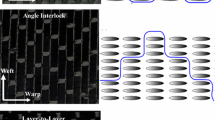Abstract
We investigate the influence of liquid type on the saturated permeability of natural fabrics in liquid composite molding processes. The permeability of flax woven fabric was characterized with two different liquids which have different viscosity, wettability, and sorption characteristics with flax fiber. From the experimental data, it was observed that the saturated permeability values were different for the liquid type. The fiber swell during the mold filling process and the corresponding change of fabric microstructure were assumed to be the main reason for this dependency of saturated permeability on the liquid type. The fiber swell due to the liquid sorption was characterized as a function of time, and the corresponding change of fiber diameter was investigated. The effective fiber volume fraction of wet natural fabric was defined in terms of fiber swelling ratio. The predictions by the classical Kozeny–Carman model and by the modified Kozeny–Carman model with two model constants were compared with the experimental data. It was shown that the modified Kozeny–Carman equation considering fiber swell could predict very well the saturated permeability of natural fabrics regardless of liquid type.











Similar content being viewed by others
References
Bismarck A, Mishra S, Lampke T (2005) Chapter 2: plant fibers as reinforcement for green composites. In: Mohanty AK, Misra M, Drzal LT (eds) Natural fibers, biopolymers and biocomposites. Taylor and Francis, Boca Raton, pp 36–112
Marsh G (2003) Next step for automotive materials. Mater Today 6(4):36–43
Masoodi R, Pillai KM, Grahl N, Tan H (2012) Numerical simulation of LCM mold-filling during the manufacture of natural fiber composites. Reinf Plast Compos 31:363–378
Baley C (2002) Analysis of the flax fibres tensile behaviour and analysis of the tensile stiffness increase. Composites A 33:939–948
Bledzki A, Gassan J (1999) Composites reinforced with cellulose based fibres. Prog Polym Sci 24(2):221–274
Ma Y, Shishoo R (1999) Permeability characterization of different architectural fabrics. J Compos Mater 33(8):729–749
Steenkamer DA, Mcknight SH, Wilkins DJ, Karbhari VM (1995) Experimental characterization of permeability of fiber wetting for liquid moulding. J Mater Sci 30:3207–3215. doi:10.1007/BF01209239
Luo YW, Verpoest I, Hoes K, Vanhule M, Sol H, Cardon A (2001) Permeability measurement of textile reinforcements with several test liquids. Composites A 32(10):1497–1504
Hammond VH, Loos AC (1997) The effects of fluid type and viscosity on the steady-state and advancing front permeability behavior of textile preforms. J Reinf Plast Compos 16(1):50–72
Masoodi R, Tan H, Pillai KM (2012) Numerical simulation of liquid absorption in paper-like swelling porous media. AIChE J 58(8):2536–2544
Languri EM, Moore RD, Masoodi R, Pillai KM, Sabo R (2010) An approach to model resin flow through swelling porous media made of natural fibers. In: The 10th international conference on flow processes in composite materials (FPCM10), Monte Verità, Ascona, Swiss, 11–15 July 2010
Arbter R et al (2011) Experimental determination of the permeability of textiles: a benchmark exercise. Composites A 42:1157–1168
Kestin J, Sokolov M, Wakeham WA (1978) Viscosity of liquid water in the range −8 °C to 150 °C. J Phys Chem Ref Data 7(3):941–948
Naik NK, Sirisha M, Inani A (2014) Permeability characterization of polymer matrix composites by RTM/VARTM. Prog Aerosp Sci 65:22–40
Charlet K, Jernot JP, Bréard J, Gomina M (2012) Scattering of morphological and mechanical properties of flax fibres. Ind Crops Prod 32(3):220–224
Pillai KM (2004) Modeling the unsaturated flow in liquid composite molding processes: a review and some thoughts. J Compos Mater 38(23):2097–2118
Dungan FD, Sastry AM (2002) Saturated and unsaturated polymer flows: microphenomena and modeling. J Compos Mater 36(13):1581–1603
Park CH, Lee WI (2011) Modeling void formation and unsaturated flow in liquid composite molding processes: a survey and review. J Reinf Plast Compos 30(11):957–977
Rodriguez E, Giacomelli F, Vazquez A (2004) Permeability–porosity relationship in RTM for different fiberglass and natural reinforcements. J Compos Mater 38(3):259–268
Francucci G, Rodríguez ES, Vázquez A (2011) Study of saturated and unsaturated permeability in natural fiber fabrics. Composites A 41:16–21
Skartsis L, Khomami B, Kardos JL (1992) Resin flow through fiber beds during composite manufacturing processes. Part II: numerical and experimental studies of Newtonian flow through ideal and actual fiber beds. Polym Eng Sci 32(4):231–239
Um MK, Lee WI (1997) A study on permeability of unidirectional fiber beds. J Reinf Plast Compos 16(17):1575–1590
Gebart B (1992) Permeability of unidirectional reinforcements for RTM. J Compos Mater 26:1100–1133
http://imagej.nih.gov/ij/. Accessed 13 June 2014
Author information
Authors and Affiliations
Corresponding author
Rights and permissions
About this article
Cite this article
Nguyen, V.H., Lagardère, M., Park, C.H. et al. Permeability of natural fiber reinforcement for liquid composite molding processes. J Mater Sci 49, 6449–6458 (2014). https://doi.org/10.1007/s10853-014-8374-1
Received:
Accepted:
Published:
Issue Date:
DOI: https://doi.org/10.1007/s10853-014-8374-1




